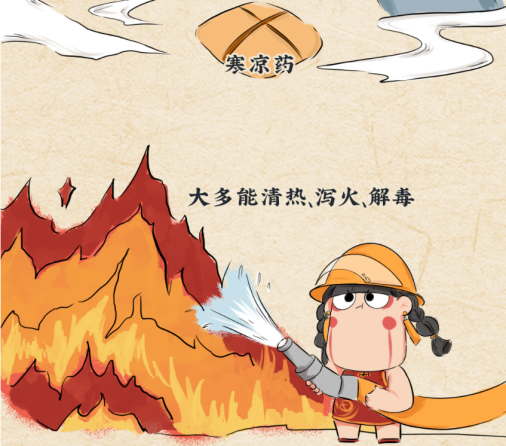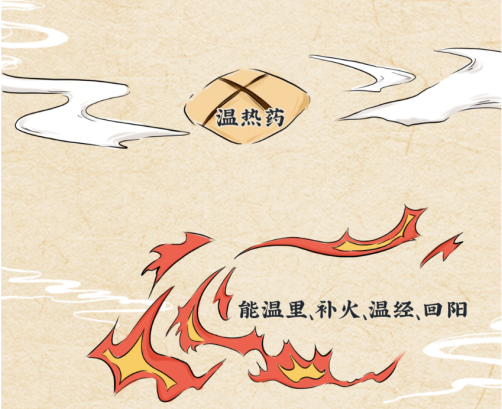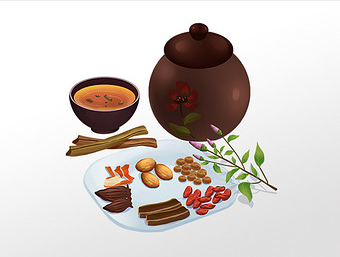As we all know, there are four seasons in a year, each with different temperatures: cold in winter and hot in summer. Similarly, Chinese medicine also categorizes herbs based on their thermal properties, which are divided into four types: cold, hot, warm, and cool, known as “Si Qi“. This classification reflects the tendency of herbs to influence the balance of yin and yang in the body and the changes in temperature (properties), making it one of the important concepts in explaining the nature of herbal actions.1 Perception of the “Temperature” of Chinese Medicine The warm and hot properties in “Si Qi” belong to two different categories, with warm and hot being yang, and cold and cool being yin. Warm is less intense than hot, and cool is less intense than cold, indicating a degree of difference within the shared properties. For some herbs, they are often marked with terms like major heat, major cold, mild warmth, and mild cold to further distinguish their thermal properties, which is a further classification of the degrees of the “Si Qi” of Chinese herbs. The determination of an herb’s property is based on the response to its use, with the cold and heat nature of the disease as the benchmark. The properties of herbs—cold, hot, warm, and cool—are summarized from the reactions that occur when the herbs act on the body, corresponding to the cold and heat nature of the diseases treated. Generally speaking, cold and cool herbs have the effects of clearing heat, draining fire, cooling the blood, and detoxifying; while warm and hot herbs have the effects of warming the interior, dispersing cold, supplementing fire, assisting yang, warming the meridians, and rescuing from collapse.2 Identifying Common Chinese Herbs’ “Temperature”(1) Cold and Cool Herbs
Herbs that can alleviate or eliminate heat syndromes generally belong to the cold or cool category. For example, Huang Qin (Scutellaria baicalensis) and Ban Lan Gen (Isatis indigotica) have heat-clearing and detoxifying effects for symptoms like fever, thirst, and sore throat, indicating that these two herbs possess cold properties.

1. Sang Shen (Mulberry Fruit)
【Properties and Channels】Sweet, sour, cold. Enters the Heart, Liver, and Kidney channels.
【Functions and Indications】Nourishes yin, replenishes blood, generates fluids, and moistens dryness. Used for liver and kidney yin deficiency, dizziness, tinnitus, palpitations, insomnia, premature graying of hair, fluid damage leading to thirst, internal heat causing thirst, and constipation due to dryness.
2. Jin Yin Hua (Honeysuckle Flower)
【Properties and Channels】Sweet, cold. Enters the Lung, Heart, and Stomach channels.
【Functions and Indications】Clears heat and detoxifies, disperses wind-heat. Used for carbuncles, sore throat, erysipelas, heat-toxicity causing dysentery, wind-heat colds, and febrile diseases.
3. Ju Hua (Chrysanthemum Flower)
【Properties and Channels】Sweet, bitter, slightly cold. Enters the Lung and Liver channels.
【Functions and Indications】Disperses wind, clears heat, calms the liver, and brightens the eyes. Used for wind-heat colds, headaches, dizziness, red and swollen eyes, blurred vision, and carbuncles.

(2) Warm and Hot Herbs
Herbs that can alleviate or eliminate cold syndromes generally belong to the warm or hot category. For example, Fu Zi (Aconitum carmichaelii) and Gan Jiang (Zingiber officinale) have warming effects for symptoms like abdominal cold pain, cold limbs, and weak pulse, indicating that these two herbs possess hot properties.

1. Da Zao (Jujube)
【Properties and Channels】Sweet, warm. Enters the Spleen, Stomach, and Heart channels.
【Functions and Indications】Tonifies the middle, benefits qi, nourishes blood, and calms the spirit. Used for spleen deficiency with poor appetite, fatigue, loose stools, and irritability in women.
2. Long Yan Rou (Longan Flesh)
【Properties and Channels】Sweet, warm. Enters the Heart and Spleen channels.
【Functions and Indications】Nourishes the Heart and Spleen, nourishes blood, and calms the spirit. Used for qi and blood deficiency, palpitations, forgetfulness, insomnia, and blood deficiency leading to sallow complexion.
3 Distinguishing the “Temperature” of Patent Medicines(1) Warm and Spicy Exterior-Releasing Formulas
Warm and spicy exterior-releasing formulas are used to alleviate or eliminate cold syndromes, suitable for wind-cold colds. Wind-heat colds should not use warm and spicy exterior-releasing formulas.
1. Jing Fang Granules
【Functions and Indications】
Induces sweating and releases the exterior, disperses wind and eliminates dampness. Used for wind-cold colds, headaches, body aches, chills without sweating, nasal congestion with clear discharge, and cough with white phlegm.
2. Du Liang Soft Capsules
【Functions and Indications】
Dispels wind, disperses cold, invigorates blood, and unblocks meridians. Used for headaches due to wind-cold and blood stasis, with symptoms of head heaviness or stabbing pain, localized pain, recurrent episodes, and exacerbation by wind and cold.
(2) Cool and Spicy Exterior-Releasing Formulas
Cool and spicy exterior-releasing formulas are used to alleviate or eliminate heat syndromes, suitable for wind-heat colds. Wind-cold colds should not use cool and spicy exterior-releasing formulas.

1. Yin Qiao Jie Du Granules
【Functions and Indications】
Disperses wind, releases the exterior, clears heat, and detoxifies. Used for wind-heat colds, with symptoms of fever, headache, cough, dry mouth, and sore throat.
2. Shuang Huang Lian Oral Liquid
【Functions and Indications】
Disperses wind, releases the exterior, clears heat, and detoxifies. Used for colds caused by wind-heat, with symptoms of fever, cough, and sore throat.
3. Anti-Viral Granules
【Functions and Indications】
Clears heat, eliminates dampness, cools the blood, and detoxifies. Used for wind-heat colds, upper respiratory infections, and influenza.
4. Compound Cold Medicine Granules
【Functions and Indications】
Cool and spicy exterior-releasing, clears heat, and detoxifies. Used for fever due to wind-heat colds, with mild aversion to wind and cold, headache, body aches, dry mouth and thirst, nasal congestion with thick discharge, sore throat, cough, and yellow sticky phlegm.
5. Chai Huang Granules
【Functions and Indications】
Clears heat and detoxifies. Used for upper respiratory infections and fever due to colds.
6. Chai Hu Injection
【Functions and Indications】
Clears heat and releases the exterior. Used for treating fever due to colds, influenza, and malaria.
References
[1] Pharmacopoeia of the People’s Republic of China, 2020 Edition
[2] Drug Instructions (2020-12-01) – Jing Fang Granules (Jiuzhaigou Natural Pharmaceutical Co., Ltd.)
[3] Drug Instructions (2020-10-23) – Du Liang Soft Capsules (Chongqing Huasen Pharmaceutical Co., Ltd.)
[4] Drug Instructions (2020-12-30) – Yin Qiao Jie Du Granules (Shandong New Mainland Pharmaceutical Co., Ltd.)
[5] Drug Instructions (2020-06-29) – Shuang Huang Lian Oral Liquid (Henan Tailong Pharmaceutical Co., Ltd.)
[6] Drug Instructions (2021-11-18) – Anti-Viral Granules (Sichuan Guangda Pharmaceutical Co., Ltd.)
[7] Drug Instructions (2022-06-16) – Compound Cold Medicine Granules (Guangxi Baoruitan Pharmaceutical Co., Ltd.)
[8] Drug Instructions (2020-09-08) – Chai Huang Granules (Sichuan Baili Pharmaceutical Co., Ltd.)
[9] Drug Instructions (2018-06-29) – Chai Hu Injection (Henan Runhong Pharmaceutical Co., Ltd.)
Submitted by | Pharmacy Department, Xiong FeiEdited by | Zhao XianInitial Review | Yang XiaoliRe-review | Liu FengqiongFinal Review | Fu XiaolanDisclaimer: Except for original content and special notes, some text and images are sourced from the internet and major media outlets. Copyright belongs to the original authors. If you believe the content infringes on your rights, please contact us for removal.

 Selected Past Issues
Selected Past Issues
●【Technical Discipline】The Oncology Department of Changshou District Traditional Chinese Medicine Hospital Successfully Conducts Partial Embolization of the Splenic Artery for Treating Splenic Hyperfunction
●The Most Beautiful “Goddess of Fertility” Liu Qirong
●【Good News】The Acupuncture Department of Changshou District Traditional Chinese Medicine Hospital Awarded the Honorary Title of “Youth Civilization” in Chongqing

